![]()
![]()
![]()
Use LEFT and RIGHT arrow keys to navigate between flashcards;
Use UP and DOWN arrow keys to flip the card;
H to show hint;
A reads text to speech;
35 Cards in this Set
- Front
- Back
|
what three things do diuretics increase
|
urine flow rate
urinary sodium excretion urinary water excretion |
|
|
what percentage approximately of filtered Na and water is excreted
|
Na 0.5%
water 1% |
|
|
what is the main mechanism of diuresis by diuretics
|
decreasing reabsorption of Na
|
|
|
what is another mechanism of diuresis (but not main)
|
increase in GFR
|
|
|
what are non reabsorbable solute "osmotic diuretics"?
|
molecules that are given which are not able to be reabsorbed due to big size hence causing diuresis
|
|
|
what are two eg of osmotic diuretics
|
Mannitol IV
Glucose excess |
|
|
What is the term for decreased Na reabsorption
|
Natriuresis
|
|
|
where are the 5 nephron sites of Na reabsorption
|
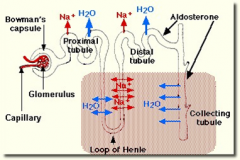
1. proximal tubule
2. ascending limb of loop of henle 3. distal tubule 4. early collecting tubule 5. late collecting tubule |
|
|
how does blocking the Na movement at the ascending limb of the loop of henle affect the urine?
|
The urine is unable to be DILUTED or CONCENTRATED with sodium
|
|
|
how does blocking the Na movement at the distal tubule affect urine?
|
you can't DILUTE the urine
|
|
|
what two ions are affected by diuretics (other than Na and H2O)
|
potassium (hypokalaemia)
H+ ions (alkalosis) |
|
|
what are the three receptors for Na in the proximal tubule
|
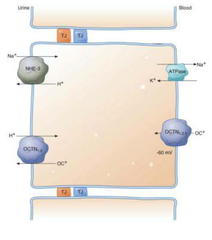
1. facilitated transport of Na + glucose/phosphate etc
2. antiport of Na and H+ 3. Na+/K+ATPase |
|
|
what happens to H+ that is secreted into the brush border the ureter
|
combines with HCO3 -> H2CO3
broken down by carbonic anhydrase to H2O and CO2 |
|
|
what happens to the H2O and CO2 that is produced by the H+ ions at the brush border of the ureter
|
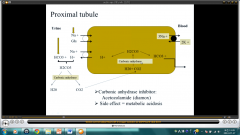
it is reabsorbed back into the proximal tubule to combine to H2CO3> HCO3+ + H+
then HCO3+ is reabsorbed back into the blood (balances pH and prevents acidosis) |
|
|
what is the mechanism of azetozolamide
|
carbonic anhydrase inhibitor
this inhibits the breakdown of H2CO3 in the brush border hence slows the antiport receptor and reabsorption of HCO3+ back into blood result: diuresis |
|
|
what is the side effect of azetolamide
|
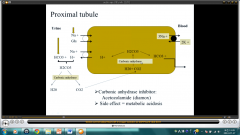
metabolic acidosis
less HCO3+ reabsorbed into the blood |
|
|
http://www.youtube.com/watch?v=6Wc4f2KnbYo
diuretic actions |
..
|
|
|
what are the two receptors for sodium in the ascending limb of the loop of henle?
|
1. 3Na/2K ATPase
2. Na/K/Cl Co transporter |
|
|
How does lasix work? (furesemide)
|
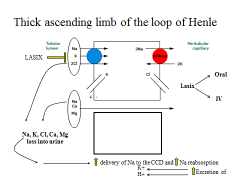
blocks the Na/K/Cl Co transporter
decreases the Na reabsorption hence inc Na excretion Natriuresis and diuresis |
|
|
what other ions are lost in excretion with lasix?
|
Calcium and magnesium
|
|
|
where does the hypokalaemia occur with loop diuretics?
|
COLLECTING TUBULES
Not at the ascending limb you send more Na down to the collecting tubule with loop diuretics This will cause more Na reabsorption at the collecting tubules hence more K secretion (hypokalaemia) at the collecting tubules |
|
|
what side effect regarding ions is associate with thiazides
|
hypercalcaemia
|
|
|
which diuretic is erecticle dysfunction associated with
|
thiazides
|
|
|
above what CrCL does thiazides work
|
above 30 mL/min
because the thiazides have to be filtered to work |
|
|
which type of diuretics have a vasodilatory effect
|
thiazides
|
|
|
what does lasix in high doses cause for elderly
|
deafness
more likely to occur in ppl taking other contributing drugs like gentamicin |
|
|
what are the four sfx of diuretics starting with 'hypo'
|
hypovolaemia
hyponatraemia hypokalaemia hypomagnesemia |
|
|
where does metabolic acidosis occur in the nephron
|
proximal tubule
|
|
|
where does hyperkalaemia occur in the nephron
|
collecting tubule
|
|
|
what are three metabolic sfx to diuretics
|
glucose intolerance (changes insulin receptors and also from hypokalaemia
hyperlipidaemia hyperuricaemia |
|
|
what is the mechanism of hyperlipidaemia in diuretics?
|
unclear
but it may be activation of SNS, RAAS, insulin sensitivity |
|
|
what is the mechanism of the sfx hyperuricaemia
|
directly and indirectly increases uric acid reabsorption in the proximal tubule
|
|
|
what is one diuretic that is not associated with hyperlipidaemia
|
indapamide
|
|
|
what is a natural diuretic
|
parsley
|
|
|
what natural food causes hypertension and hyperkalaemia
|
liquorice
|

